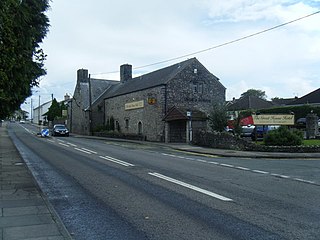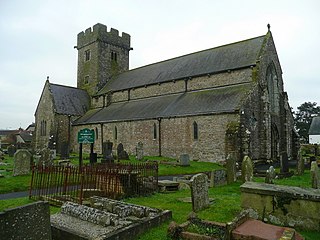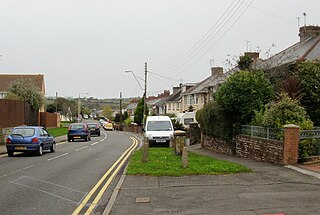
The Vale of Glamorgan, often referred to as The Vale, is a county borough in the south-east of Wales. It borders Bridgend County Borough to the west, Cardiff to the east, Rhondda Cynon Taf to the north, and the Bristol Channel to the south. With an economy based largely on agriculture and chemicals, it is the southernmost unitary authority in Wales. Attractions include Barry Island Pleasure Park, the Barry Tourist Railway, Medieval wall paintings in St Cadoc's Church, Llancarfan, Porthkerry Park, St Donat's Castle, Cosmeston Lakes Country Park and Cosmeston Medieval Village. The largest town is Barry. Other towns include Penarth, Llantwit Major, and Cowbridge. There are many villages in the county borough.

Bridgend is a town in the Bridgend County Borough of Wales, 20 miles (32 km) west of Cardiff and 20 miles (32 km) east of Swansea. The town is named after the medieval bridge over the River Ogmore. The River Ewenny also flows through the town. The population was 49,597 in 2021. Bridgend is within the Cardiff Capital Region which in 2019 had a population of approximately 1.54 million.

Bridgend County Borough is a county borough in the south-east of Wales. The county borough has a total population of 139,200 people, and contains the town of Bridgend, after which it is named. Its members of the Senedd are Sarah Murphy MS, representing the Bridgend Constituency, and Huw Irranca-Davies MS representing the Ogmore Constituency, and its members of the UK parliament are Jamie Wallis and Chris Elmore.

Ewenny is a village and community (parish) on the River Ewenny in the Vale of Glamorgan, Wales.

Colwinston is both a village and a community in the Vale of Glamorgan, Wales, approximately 4 miles (6.4 km) southeast of the centre of Bridgend and 21 miles (34 km) west of the centre of Cardiff. The village is located within 1⁄2 mile (0.80 km) of the A48. The population in 2005 was approximately 400 but with recent building development, the population is now estimated at over 600 people.
Brackla is a large housing estate and community in the east of Bridgend in Bridgend County Borough, Wales. Along with the communities of Bridgend and Coychurch Lower, it makes up the town of Bridgend.

Pyle is a village and community in Bridgend county borough, Wales. This large village is served by the A48 road, and lies less than one mile from Junction 37 of the M4 motorway, and is therefore only a half-hour journey from the capital city of Wales, Cardiff. The nearest town is the seaside resort of Porthcawl. Within the Community, to the northeast of Pyle, is the adjoining settlement of Kenfig Hill, North Cornelly also adjoins Pyle and the built-up area had a population of 13,701 in 2011.

Coychurch is a small village that sits between Pencoed and Bridgend in Wales, bordering with Bridgend Industrial Estate, where many residents are employed. It is part of the community of Coychurch Lower.

Saint Canna was a sixth-century mother of saints and later a nun in south Wales.

Llanharan is a village and community in the county borough of Rhondda Cynon Taf, Wales. As a community Llanharan takes in the neighbouring settlements of Bryncae, Brynna, Llanilid, Peterston-super-Montem and Ynysmaerdy. Llanharan thrived during the British Industrial Revolution, with several tin and coal mines in the location providing employment to the town's residents. With the decline of heavy industry in the South Wales Coalfield, Llanharan has been in economic decline, though its proximity to the M4 motorway offers its residents easy commutable access to most of South Wales.

John Prichard was a Welsh architect in the neo-Gothic style. As diocesan architect of Llandaff, he was involved in the building or restoration of many churches in south Wales.

Coity is a village in Bridgend County Borough, south Wales, part of Bridgend town urban area. Coity is part of the community of Coity Higher and is notable for being home to Coity Castle, one of the best preserved castles in Glamorgan. Other buildings of note in the village include St Mary, a 14th-century church, and Ty Mawr, a fine 16th-century house.

Laleston is a village and a community in Bridgend County Borough, south Wales, directly west of Bridgend town centre. The village takes its name from the Norman Lageles family who settled in the area. Buildings of note in the village include St David's Church, which still possesses features dating back to the 13th and 14th centuries, the Great House which was built in the early 16th century and Horeb Welsh Presbyterian Church (1831).
Newcastle Higher is a community in Bridgend County Borough, south Wales. Located north west of Bridgend town centre it is made up of the townships of Pen-y-fai and Aberkenfig and straddles the M4 motorway. The community is home to several notable buildings, including the Pen-y-fai Hospital, Court Coleman and All Saints Church.

Coychurch Higher is a community in Bridgend County Borough, south Wales. It covers the westerly area of the county north of Pencoed and south of Ogmore Vale. The community is sparsely populated and contains only one settlement, the small village of Heol-y-Cyw, which is located on the southerly border of the community. The majority of the community is made up of hilly terrain populated by several farm houses. It was once the site of Wern Tarw Colliery, the site of the first major coalminers' strike post-nationalisation of the coal industry. The population of the community in 2011 was 888.
Bridgend is a community in Bridgend County Borough, south Wales. Along with the communities of Brackla, Coychurch Lower and Laleston it makes up the town of Bridgend. Bridgend is the western district of Bridgend town, and takes in the town centre, Newcastle Hill, Tremains and to the north Wild Mill. The population of the community of Bridgend at the 2001 census was 13,950, increasing to 14,912 in the 2011 census.

Llangynwyd Middle is a community in Bridgend County Borough, south Wales. It is located to the south of Maesteg and contains the villages of Llangynwyd and Cwmfelin. At the 2001 census, the population of the community was 2,843, increasing to 3,032 at the 2011 Census.

Tythegston is a conservation area village located close to Cardiff and Swansea on the south coast of Bridgend, Wales. It is home to Tythegston Court, a Grade II listed manor house at the centre of the 1,200 acre Tythegston Estate which is designated at Grade II on the Cadw/ICOMOS Register of Parks and Gardens of Special Historic Interest in Wales. The estate has been owned by the Knight family for some 350 years and operates as a farming and property enterprise, with an industrial estate, as well as hosting green energy and food production. The seaside town of Porthcawl, with its numerous beaches is within 3 miles, as is Bridgend inter-city rail station. The village covers an area of 2,871 acres (1,162 ha). It is part of the community of Merthyr Mawr.

St Crallo's Church, often referred to historically as The Cathedral of the Vale of Glamorgan, is a Grade I listed church in Coychurch Lower, Bridgend County Borough, southern Wales.

Litchard is a village and residential district north of Bridgend, Wales. It is also an electoral ward in the Coity Higher community, as well as a former ward to Bridgend County Borough Council.



















